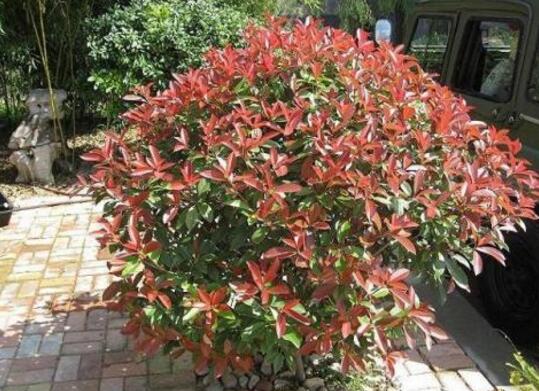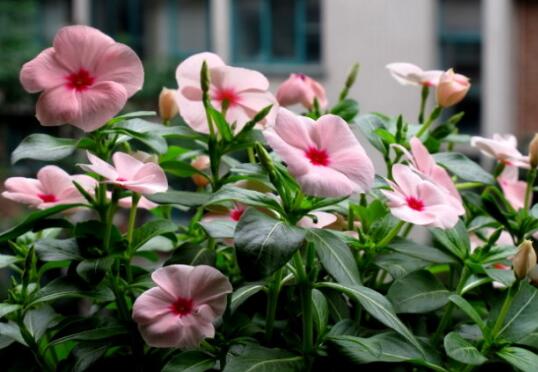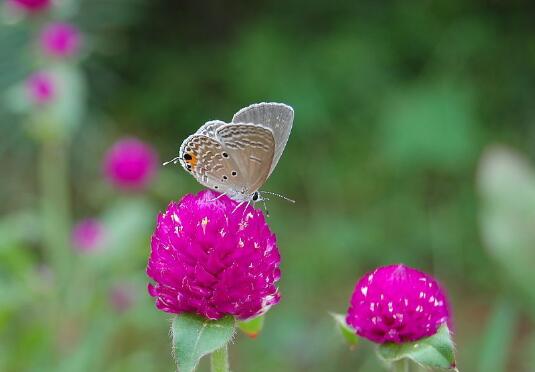Is Photinia mandshurica toxic? the key points of bonsai production technology / soil is very important.
Photinia rubra is a common green belt plant because of its high ornamental value, but for some people who want to plant it indoors, the more concerned problem is toxicity, so is Photinia rubra poisonous? Is the indoor pot of red leaf heather suitable? With these questions, let's find the answers.
Is Photinia rugosa poisonous?

In nature, there are many brightly colored plants that are toxic to a certain extent, so some flower friends think that Photinia rubra with bright red leaves is no exception, so is Photinia rugosa poisonous? The answer is non-toxic. The branches and leaves of Photinia are non-toxic, and not only that, it is also a good industrial raw material.
Is it suitable for indoor potted plants of Photinia rugosa
Since Photinia rubra is non-toxic, is it suitable for indoor potted plants? The answer is yes. Keeping it indoors can not only play an ornamental role, but also purify indoor air, beautify the environment, etc., especially in spring and autumn to see bright red leaves, more refreshing, but potted plants need to pay attention to the following points.
Technical points of bonsai production of Photinia rugosa
1. Varieties and containers
If it is potted Photinia rubra, it should be suitable for cutting seedlings or tissue culture of small seedlings, these species can be trimmed into short shrubs, plant height can be controlled above 1.5 meters, more suitable for indoor planting.
2. Soil selection.
We know that Photinia rubra has no high demand for soil, but if it is a potted plant, the acid soil with a PH value of 5.5-6.5 is the best, and the sandy soil is the best, because it has better air permeability and drainage, and can create a more favorable soil environment for growth.
3. Potting skills
When potting, the roots should not be planted too deep, generally as long as 2/3 of the roots are in the soil, and the roots should be stretched as far as possible, and the plants should be upright and not tilted, so as to avoid the appearance of crooked growth in the process of growth.
4. apply base fertilizer to the bottom of the basin.
In the key points of bonsai production technology, the biggest difference between it and garden planting is the application of base fertilizer. In the cultivation method of potted photinia, base fertilizer should be applied at the bottom of the pot, or organic fertilizer should be mixed into the soil. So that Photinia can get enough nutrients at the beginning of the growing period.
Chicken claw maple bonsai pictures and planting techniques in plant potted plants, the graceful posture and beautiful leaf shape of the chicken claw maple tree are loved and favored by people from all walks of life. In horticulture, the leaf shape and color of its varieties are changeable, which is very aesthetic. If it is planted in lawns, streams, poolsides, corners of walls, pavilions or rocks, it is quite natural and elegant. After autumn, the bright red chicken claw maple bonsai pictures are as colorful as flowers and brilliant as glow. As an excellent foliage tree species, it is believed that no matter where it is planted, it has the beauty of natural elegance. In this paper, combined with the pictures of Acer truncatum, we will tell you about the seedling price and the planting technology of Acer. [Xiaobian strongly recommended] Hongyun's leading culture method, how to raise hanging orchids, what plants absorb formaldehyde, the propagation method of azaleas, the price of Dendrobium candidum
[plant archives]-English name: chicken claw maple scientific name: Japanese Maple alias: chicken claw maple, Aceraceae: Aceraceae: Acer distribution: Shandong, southern Henan, Jiangsu, Zhejiang, Anhui, Jiangxi, Hubei, Hunan, Guizhou and other provinces Korea, Japan and other countries are also distributed. Morphological features: deciduous small trees or trees, umbrella-shaped crown, elegant posture. The bark is smooth. Branchlets reddish brown. Leaves opposite, palmately 7-9-lobed, basal truncate to form a heart. Lobes apex caudate, margin with irregular or double sharp teeth, young leaves densely pilose, old leaves smooth and glabrous. The red leaves in autumn are very pleasing to the eye. Flowers polygamous, composed of purplish red florets in corymbose inflorescences, blooming in April. Samara spread into obtuse angles, curved upward, mature in October, brownish yellow.
Planting technique of Acer truncatum
The ecological characteristics of Acer truncatum-like warm, humid and semi-shady environment. Cold-resistant, not resistant to water and moisture, more resistant to drought, afraid of strong light exposure. The suitable temperature for growth is 1525 ℃, and it can withstand low temperature of-8 ℃ in winter. The soil is a deep, fertile and well-drained sandy loam, but also resistant to acid and calcareous soil. The propagation method of Acer truncatum-Ⅵ sowing: collecting seeds in October, slightly drying off wings, sowing in autumn or wet sand stratification, sowing in spring and February. Cover soil 1 cm and sprout 30-40 days after sowing. Seedlings should be shaded and moisturized. The height of the seedlings in that year can reach 30cm to 40cm. Ⅶ grafting: mainly used for cultivated varieties, rootstock for 2-3-year-old Acer truncatum. Branch grafting was carried out in March in spring, cutting or ventral grafting was carried out when the leaf buds of rootstocks were enlarged, and bud grafting was carried out in August in summer, mainly with single bud ventral grafting, and the survival rate was high. It would have been a seedling in that year. Ⅷ striping: carried out in October, using high-altitude crimping method. Circular peeling was carried out at 20-25 cm from the top of the branch and wrapped with rotten leaf soil and film. The seedlings will grow in the following spring.
The main points for the planting of Acer mongolica-Acer truncatum should be planted in fertile, semi-shady and humid sites after defoliation in autumn and winter or before sprouting in spring. Pot planting should be carried out after the leaves are removed in late August, put in a semi-shady and moist place, and fertilize 1-2 times to promote luxuriant branches and leaves. After frost, the leaves turn yellow and red, and the leaves are maintained in the room, and the shedding of the leaves is delayed, which can prolong the viewing period. Pest control-in the cultivation of Acer davidiana, anthracnose, leaf spot and black spot are often harmed, and usually can be sprayed with Bordeaux solution or 70% mancozeb wettable powder 600 times. Insect pests include diamondback moth, large coir moth, aphids and longicorn beetles, which can be sprayed with 1500 times of fenitrothion.
Acer maple seedling price-Acer maple seedling price will also vary with different varieties and specifications. Here the editor has collected some price lists of Acer maple seedlings for your reference. Price of Acer maple seedlings (H: high cm unit / yuan) Note: the following seedlings have large specifications, 2-15 cm, varieties, specifications, unit price, varieties, specifications, unit price, species, specifications, unit price, Schima superba, H300.2, red beech, H301, maple H600.25, purple myrtle, H700.6, oil tung, H600.5, Huangshan maple, H600.3 sassafras, H500.65, metasequoia H600.12, slash pine H200.15, slash pine H200.15, Liriodendron H500.35. Cinnamomum camphora H400.25 Duying H800.5 Photinia H301 Chongyang wood H600.3 Osmanthus H300.6
[more plant encyclopedia] forget what is the symbolic significance of lilies, the efficacy and function of mulberry trees, how to plant peony flowers, knowledge of cactus, gardenia, is the flower language of lavender is what gardenia leaves are yellow, potted vegetables, asparagus, the role of green apples, the role of hyacinths, flowers and fairies. How to cultivate flowers and lilies Flower Culture methods Flower Culture potted plants radiation-proof plants Indoor plants hydroponic plants Flower language Flower Pictures Flower Pictures and names
Chicken claw maple leaf shape is beautiful, is a kind of foliage plant, generally planted on both sides of the road and other places, and now there are potted species planted in the home, chicken claw maple culture method: chicken claw maple (Acer palmatum Thunb), also known as chicken claw maple, belongs to Aceraceae, Acer belongs to deciduous small trees or trees, crown umbrella-shaped, elegant posture. The bark is smooth. Branchlets reddish brown. Leaves opposite, palmately 7-9-lobed, base truncate to form a heart. Lobes apex caudate, margin with irregular or double sharp teeth, young leaves densely pilose, old leaves smooth and glabrous. The red leaves in autumn are very pleasing to the eye. Flowers polygamous, composed of purplish red florets in corymbose inflorescences, blooming in April. Samara spread into obtuse angles, curved upward, mature in October, brownish yellow. The cultivation methods of Acer truncatum are as follows: 1. Soil: Acer mongolica has strong vitality, so it is appropriate to choose the place with high dry and sunny topography, loose and fertile soil pile and deep soil layer. Do not plant in low-lying stagnant water, heavy soil, otherwise it will grow badly. 2. Watering: potted Acer frutescens should be well watered during the growing season, but not too much, so as to keep the pot soil moist. 3. Sunshine: Acer truncatum is a weakly positive tree species with tolerance to half-shade, and it is easy to be damaged by sunburn in summer when planted alone in direct sunlight. Spring and autumn can be put on the balcony or courtyard training, summer moved to semi-shade, pay attention to appropriate shade, prevent hot sun exposure, resulting in scorched leaf edge. If you need to watch it indoors, you should put it in a place with sufficient light, and pay attention to ventilation. After placing it for a period of time, move it to the outdoor sunny place for training. 4. Temperature: Acer truncatum likes warm climate. Before entering winter in the north, it should be moved to a cold room for winter and placed in a room with a room temperature of 0-5 ℃. 5. Fertilization: potted Acer frutescens, generally apply thin cake fertilizer water once a month from spring sprouting, and change to potash fertilizer from September. If 0.5% mi 1% potassium sulfate solution or plant ash leaching solution is applied, the leaf color will be bright. 6. Insect pests: the common pests of Acer maple are grubs, mole crickets, beetles, thorns, aphids, longicorn beetles, heart borer and so on. To give priority to prevention, spray carbendazim or enamylmorpholine or acylmorpholine EC + Ningnanmycin + avermectin + cyhalothrin or chlorpyrifos or acetamiprid + organosilicon 3000 times, once every 15-20 days when the disease is free and 5-7 days when the disease is serious. Pay attention to the alternate use of medicine. The leaf shape of Acer maple is unique and beautiful, and it will change color after autumn, and the ornamental value is good. Pot planting is also a good choice to beautify the environment indoors. The breeding method of Acer maple is introduced here. I hope it will be helpful to you.
Pictures of Acer chinensis, price of Acer mongolica seedlings, bonsai pictures and planting techniques
After autumn, the bright red chicken claw maple bonsai pictures are as colorful as flowers and brilliant as glow. As an excellent foliage tree species, it is believed that no matter where it is planted, it has the beauty of natural elegance. In this paper, combined with the pictures of Acer truncatum, we will tell you about the seedling price and the planting technology of Acer. [Xiaobian strongly recommended] Hongyun's leading culture method how to raise hanging orchid what plant absorbs formaldehyde Azalea propagation method Dendrobium candidum price [chicken foot maple] chicken foot Acer seedling price, chicken foot Acer planting technology, chicken foot Acer bonsai picture-
[plant archives]-
English name: Acer truncatum
Scientific name: Japanese Maple
Alias: chicken claw maple, maple tree
Family: Aceraceae
Genus: Acer
Distribution of origin: Shandong, southern Henan, Jiangsu, Zhejiang, Anhui, Jiangxi, Hubei, Hunan, Guizhou and other provinces; Korea, Japan and other countries.
Morphological features: deciduous small trees or trees, umbrella-shaped crown, elegant posture. The bark is smooth. Branchlets reddish brown. Leaves opposite, palmately 7-9-lobed, basal truncate to form a heart. Lobes apex caudate, margin with irregular or double sharp teeth, young leaves densely pilose, old leaves smooth and glabrous. The red leaves in autumn are very pleasing to the eye. Flowers polygamous, composed of purplish red florets in corymbose inflorescences, blooming in April. Samara spread into obtuse angles, curved upward, mature in October, brownish yellow.
Planting technique of Acer truncatum
Ecological characteristics of Acer truncatum
Like a warm, humid and semi-overcast environment. Cold-resistant, not resistant to water and moisture, more resistant to drought, afraid of strong light exposure. The suitable temperature for growth is 1525 ℃, and it can withstand low temperature of-8 ℃ in winter. The soil is a deep, fertile and well-drained sandy loam, but also resistant to acid and calcareous soil.
The breeding method of Acer truncatum
Ⅵ sowing: collecting seeds in October, slightly drying off wings, sowing in autumn or wet sand stratification, sowing in spring and February. Cover soil 1 cm and sprout 30-40 days after sowing. Seedlings should be shaded and moisturized. The height of the seedlings in that year can reach 30cm to 40cm.
Ⅶ grafting: mainly used for cultivated varieties, rootstock for 2-3-year-old Acer truncatum. Branch grafting was carried out in March in spring, cutting or ventral grafting was carried out when the leaf buds of rootstocks were enlarged, and bud grafting was carried out in August in summer, mainly with single bud ventral grafting, and the survival rate was high. It would have been a seedling in that year.
Ⅷ striping: carried out in October, using high-altitude crimping method. Circular peeling was carried out at 20-25 cm from the top of the branch and wrapped with rotten leaf soil and film. The seedlings will grow in the following spring.
The main points of planting Acer truncatum
Acer truncatum should be planted in fertile, semi-shady and humid sites after defoliation in autumn and winter or before sprouting in spring. Pot planting should be carried out after the leaves are removed in late August, put in a semi-shady and moist place, and fertilize 1-2 times to promote luxuriant branches and leaves. After frost, the leaves turn yellow and red, and the leaves are maintained in the room, and the shedding of the leaves is delayed, which can prolong the viewing period.
Pest control--
In the cultivation of Acer chinensis, anthracnose, leaf spot and black spot are often harmed, and usually can be sprayed with Bordeaux solution or 70% mancozeb wettable powder 600 times. Insect pests include diamondback moth, large coir moth, aphids and longicorn beetles, which can be sprayed with 1500 times of fenitrothion.
The price of Acer maple seedlings-
The price of Acer maple seedlings will also vary with different varieties and specifications. Here, the editor has collected some price lists of Acer maple seedlings for your reference.
Price of Acer maple seedlings
Reference price of one-year-old seedlings (H: high cm unit / yuan) Note: the following seedlings have a large size of 2-15 cm.
Variety specification unit price Pushu H300.8 Schima superba H300.2 red beech H301 maple H600.25 purple myrtle H700.6 oil tung H1001 triangular maple H600.5 Huangshan maple H600.3 sassafras H500.65 metasequoia H600.12 slash pine H200.15 Liriodendron chinense H500.35 camphor H400.25 Duying H800.5 red leaf heather H301 Chongyang H600.3 Osmanthus H300.6
[more Encyclopedia of plants]
Forget what is the symbolic significance of lilies the efficacy and function of thousand-day red the function of mulberry trees how to plant peonies and raise flowers knowledge
Are the species of cactus poisonous gardenia? what is the flower language of lavender? the role of potted vegetable asparagus in yellowing gardenia leaves
The function of green apple hyacinth flower language cactus flower lily how to raise flower culture method flower culture potted plant radiation protection plant
Indoor plants hydroponic plants flower language flower pictures and names
- Prev

When does Catharanthus roseus blossom and the maintenance method of flowering period / fertilization frequently
In the efficacy and function of Catharanthus roseus, ornamental value is the most well-known role. When it comes to when Catharanthus roseus is the most ornamental, it must be when it blossoms, so when does Catharanthus roseus bloom? How to maintain the flowering period of Catharanthus roseus? Next, the editor will take you to learn about it.
- Next

When does thousand-day red blossom, maintain its flowering period / 4 months from July to October
Thousand-day red is a kind of highly ornamental flower plant, which can be seen in many gardens in our country. If we want to say that thousand-day red is the most ornamental moment, it must be when it blossoms, then when will it blossom? What do you need to do to maintain the flowering period of thousand-day red?
Related
- Fuxing push coffee new agricultural production and marketing class: lack of small-scale processing plants
- Jujube rice field leisure farm deep ploughing Yilan for five years to create a space for organic food and play
- Nongyu Farm-A trial of organic papaya for brave women with advanced technology
- Four points for attention in the prevention and control of diseases and insect pests of edible fungi
- How to add nutrient solution to Edible Fungi
- Is there any good way to control edible fungus mites?
- Open Inoculation Technology of Edible Fungi
- Is there any clever way to use fertilizer for edible fungus in winter?
- What agents are used to kill the pathogens of edible fungi in the mushroom shed?
- Rapid drying of Edible Fungi

